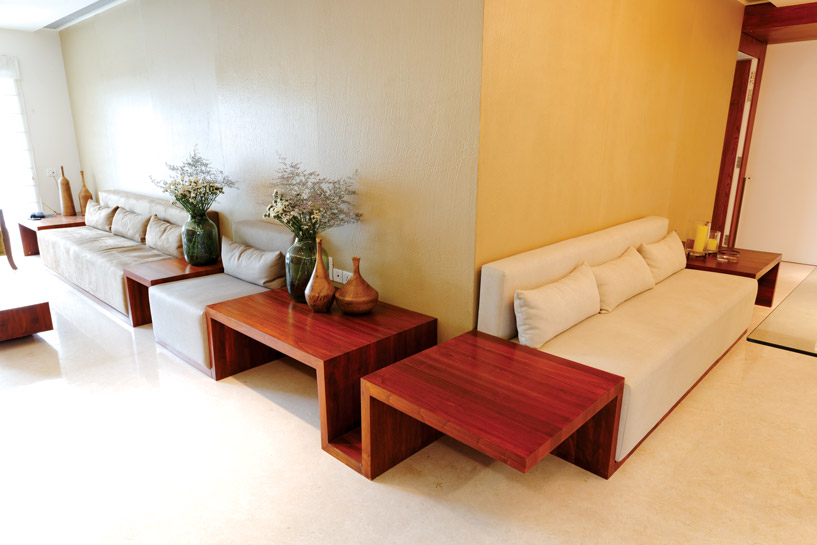
With shrinking homes, multifunctional furniture gained immense popularity in the last few years. From space-saving attributes to versatility in design, various factors fueled its rise. However, as larger and spacious homes make a comeback, Furniture Design and Technology (FDT) scrutinizes its impact and explores whether multifunctional furniture is experiencing a decline in appeal. What factors may be contributing to this potential shift in consumer preferences, or is there more to the story of multifunctional furniture?
.jpg) Photo Courtesy: Fulcrum Studio
Photo Courtesy: Fulcrum StudioTo comprehend the scope of multifunctional furniture, Furniture Design and Technology (FDT) reached out to prominent figures in the industry, spanning from furniture designers to manufacturers and interior designers, to gain invaluable insights into the prevailing market sentiment. While opinions may diverge, most agree that the market is thriving, showing high demand for these adaptable pieces.
.jpg)
The rise of multifunctional furniture has been driven by the compelling need to address the shrinking nature of urban living spaces. As real estate prices are soaring, budget-conscious individuals are on the lookout for economical and spaceefficient solutions. With the apartments becoming increasingly smaller, both homeowners and tenants confront the task of optimizing functionality within limited areas. Multifunctional furniture emerges as a star in this situation, providing compact yet effective solutions to enhance space utilization. Samiir Wheaton, Director of Wheaton Design Pvt Ltd., believes that multifunctional furniture is gaining momentum. He notes the shift towards sustainability and changing lifestyles, with families downsizing and youth embracing simplicity and community living.

The burgeoning popularity of multifunctional furniture can be attributed to its seamless integration into smaller living spaces. Multifunctional furniture serves multiple purposes, from coffee tables with hidden storage to wallmounted desks that fold away. Beds, convertible desks, modular shelving systems, nesting tables, and convertible sofas exemplify the ingenious designs enabling seamless integration into diverse living environments, offering practical solutions for modern living challenges.
 Photo Courtesy: LCOVE
Photo Courtesy: LCOVENitin Kohli, Founder and Principal Designer of Nitin Kohli Home, echoes this viewpoint, emphasizing consumers’ inclination towards multifunctional furniture for its space-saving benefits and adaptability.

Aanchal Goel, Founder of Objectry, emphasizes the perpetual relevance of multifunctional furniture in niche spaces like bedrooms and bathrooms. Ar Pravir Sethi, Principal Architect and Founder of Studio Hinge, highlights the constant demand for multifunctional furniture in cities like Mumbai, where space constraints necessitate versatile solutions.
Sachin Gupta and Neha Gupta, Founders and Interior Designers of Beyond Designs, underscore the indispensability of multifunctional furniture in crafting inspiring yet functional living spaces. They elucidate, “Today, more people are working from home and they need inspiring spaces that get them productive. So a full-fledged desk is a must, however, one may not have the space or budget to have one. In that case, a coffee table that can literally rise to the occasion is a great option. Similarly, a nightstand or dresser that can turn into a desk works fine too. Plus, if you are a family that keeps having guests stay over, then a sofa that converts into a bed becomes a big boon. These benefits of multi-functional furniture continue to make them popular.”

Multifunctional furniture is gaining popularity due to its practicality and style. Amruth Sampige, Co-founder of Dash Square, attributes this appeal to urban living constraints and the need for hidden storage. Goel emphasizes the demand for practical yet aesthetically pleasing solutions, like innovative coffee tables with storage. She is currently designing a bedside table that combines various functions for bedtime essentials.
Sachin Gupta and Neha Gupta, Founders of Beyond Designs, highlight the importance of multifunctional furniture in urban living, providing versatility without sacrificing aesthetics, especially in small spaces.

“Innovation often emerges as a solution to overcome challenges, especially in environments with limited space. Architects like Ar. Pravir from Studio Hinge and Meena Murthy Kakkar from Envisage exemplify this innovative spirit. Ar. Pravir, Principal Architect and Founder of Studio Hinge, recalls designing a kitchen counter for a client who desired a separate dry kitchen but lacked space. ‘We devised a part of the kitchen counter to function as a pull-out trolley, serving both as a bar and a dry kitchen area.’ In Mumbai, Meena Murthy Kakkar, Design Head & Partner, Envisage, furnished an entire residence with multifunctional pieces to accommodate a larger family within tight space constraints. ‘Despite Mumbai’s well-known space limitations, we successfully created an interesting and challenging home tailored to our clients’ needs,’ she shares.”
The influence of Indian millennials and Gen-Z is also being noted by the industry. Multifunctional furniture emerges as a practical solution to meet their demands, seamlessly combining aesthetics with versatility to create living spaces that reflect their values and lifestyle choices. Moreover, Millennials value furniture that incorporates technology and allows for customization to match their unique tastes.
While some praise its practicality and space-saving benefits, others question its suitability for luxurious living. As the industry responds to shifting consumer preferences and changing lifestyles, the demand for multi-functional furniture remains a dynamic affair. Ar Reny of Lizo Reny Architects, cites “We don’t notice a significant increase or decrease in the popularity of multifunctional furniture. We only suggest such furniture or spaces when the project requires it. However specific instances of designing multifunctional furniture have been limited.”
.jpg) Photo Courtesy: Dash Square
Photo Courtesy: Dash SquareReny’s views resonate with many professionals in the field who emphasize the importance of maintaining design integrity while integrating multifunctional elements. As homes transform into multifunctional environments, the demand for specialized, practical and aesthetically pleasing furniture becomes increasingly important.

The luxury market presents unique considerations. Although Manoj Shrivastava, Founder & CEO, LCOVE Space Saving Furniture recognizes the increasing demand for multifunctional furniture in 1BHK or 2BHK residences, he notes the constrained demand for such furniture in expansive, upscale residences. He says, “In the luxury segment, the need for multifunction furniture is relatively limited due to the spacious floor plates. So, in the luxury segment, the demand for multifunction furniture is not significant unless it ventures into the domain where the furniture becomes not only smart but potentially robotic.” With ample square footage available, homeowners in luxury segment prioritize bespoke, statement pieces that exude exclusivity. Sanjyt Syngh, Interior Designer at Spaces + Objects, underscores the notion that luxury is synonymous with purposeful spaces. He believes that each room or space serves a distinct purpose, and blending them diminishes their uniqueness. He does not prefer to combine spaces or utilize furniture with multiple functions.


The evolution of multifunctional furniture continues to be a dynamic journey, driven by changing consumer preferences and the imperative of sustainability. Manufacturers are increasingly innovating designs that seamlessly combine functionality with aesthetics, reflecting a broader shift towards adaptable and eco-conscious living spaces.
Multi-functional furniture contributes significantly to sustainability. By serving multiple purposes, a single piece of furniture can reduce the need for several others, thereby curbing the demand for resources and subsequent waste. In a country like India, where sustainability is gaining prominence, this aspect holds substantial value. According to Mr. Arun Gajankush, Founder, Innofur, Space- Saving Furniture, there is a growing demand for multifunctional furniture that not only serves people’s needs but also incorporates sustainable and eco-friendly materials. Mr. Manoj Tomar, Founder & Managing Director of AFC Furniture Solution, underscores the broader trends in multifunctional furniture design, highlighting adaptability, technology integration, and sustainability as key drivers.
 Photo Courtesy: Fulcrum Studio
Photo Courtesy: Fulcrum StudioMr Samiir Wheaton, Director of Wheaton Design Pvt Ltd, observes the increasing popularity of multifunctional furniture, citing examples like using a sofa as a bed or repurposing a conference table as a dining table. While acknowledging individual preferences for unique furniture items and segmented spaces, Wheaton emphasizes the inherent versatility of multifunctional furniture, which seamlessly adapts to various living scenarios.

In the contemporary age of smart homes, furniture is undergoing its own transformation, becoming inherently “smart” to meet the needs of tech-savvy individuals. Across India, consumers are embracing multi-functional furniture pieces that seamlessly integrate technology for enhanced convenience and efficiency.
 Photo Courtesy: Objectry
Photo Courtesy: ObjectryImagine a bedside table equipped with built-in wireless charging or a desk with integrated speakers. These inventive pieces not only save space but also declutter by eliminating the need for additional devices and cords. Gajankush, envisions a future where furniture seamlessly integrates with smart home systems. He emphasizes, “The future is not far when smart furniture will be controlled from the touch of mobile screens! It’s an exciting time for the whole world as technology seamlessly integrates into our daily lives, with furniture being no exception. Imagine a chair that adjusts to your perfect comfort level or a table that wirelessly charges your devices. In this evolving landscape, the possibilities are endless.”
.jpg)
Essentially, there’s a growing demand for smart furniture that merges sustainability with practicality. Consumers are increasingly valuing toxin-free materials and eco-friendly choices, prompting manufacturers to craft designs that fulfill these requirements, economical while catering to various living spaces.
Kirit Joshi, Director, Spacewood, acknowledges the niche status of smart furniture, particularly concentrated in metropolitan areas grappling with space constraints. However he believes that for smart furniture to gain more popularity, there needs to be a reduction in the cost of fittings, thus making it more accessible to a wider audience.
With increasing competition, it’s anticipated that prices will gradually decrease, making smart furniture more accessible to a broader demographic.
Designing intelligent multifunctional furniture, however, comes with its own set of challenges, as explained by Gajankush. “ Balancing aesthetics, durability, functionality, and now integrating new age technology can be a tricky act. You want a piece to transform seamlessly without looking like it’s trying too hard. And there’s the engineering puzzle – making sure everything works.”smoothly and stands up to everyday use.” he points out.
The multi-functional furniture market in India is poised for substantial growth, with a projected CAGR of 10.5% from 2023 to 2028.
As urbanization accelerates and living spaces become increasingly compact, the demand for space-saving solutions like multifunctional furniture is expected to soar. As the industry adapts, balancing functionality and luxury becomes crucial. Multifunctional furniture is popular in compact living spaces, but its appeal in upscale settings relies on innovation and customization. Architects and designers are vital in creating solutions that blend practicality with sophistication, whether through bespoke designs or adaptive methods.
.jpg)
While luxury sectors may doubt multifunctional furniture’s relevance, its importance in space optimization and versatility is clear. With innovation and evolving consumer preferences, the distinction between functionality and luxury blurs, ushering in a new era in interior design.



Furniture Design India and the magazine FURNITURE DESIGN & TECHNOLOGY (FDT magazine) are from the trusted 22-year-old media house of SURFACES REPORTER and PLY REPORTER.
FDT is a B2B monthly bilingual magazine from India that shares the pulse of the furniture business in India and connects the manufacturers, OEMS, product designers, architects, showrooms, designers and dealers.
Read More© 2025 Furniture Design and Technologies.. All Rights Reserved. Developed by eyeQ Advertising